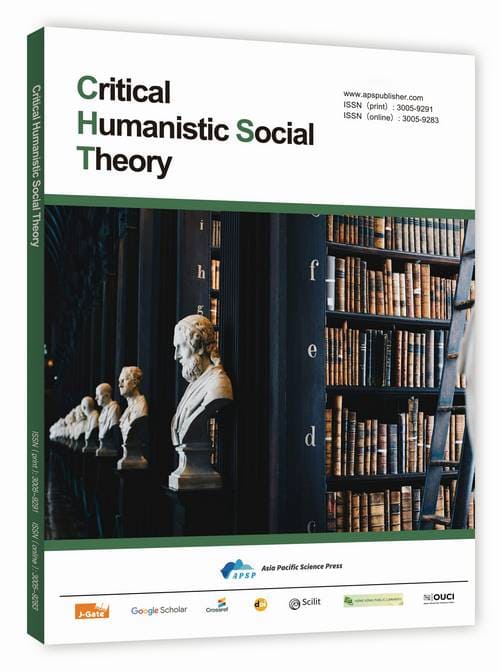Spatial Spillover Effects of Regional Social Science Influence under Chinese Modernization
Based on Panel Data of 31 Provincial National Social Science Fund Projects from 2003 to 2022 and the Perspective of Regional Coordinated Development
DOI:
https://doi.org/10.62177/chst.v2i3.566Keywords:
Spatial Spillover Effects, Regional Social Science Influence, National Social Science Fund of China (NSSFC), Spatial Durbin Model (SDM), Spatial EconometricsAbstract
In the context of Chinese modernization and the national strategy for coordinated regional development, understanding the spatial distribution and spillover effects of social science research output has become increasingly critical. This study investigates the spatial mechanisms underlying the influence of regional social sciences by analyzing panel data on National Social Science Fund of China (NSSFC) projects across 31 provinces from 2003 to 2022. Using spatial econometric models—including the Spatial Durbin Model (SDM)—and three types of spatial weight matrices (adjacency, economic distance, and inverse geographic distance), the research identifies significant spatial autocorrelation and heterogeneous spillover effects. Key findings reveal that higher education R&D personnel significantly boost local project approval rates, while their spatial spillover effects vary by matrix type—ranging from competitive crowding-out in adjacent regions to positive diffusion under geographic proximity. Funding efficiency demonstrates robust positive spillovers, whereas individual project conversion ratios exhibit negative externalities, indicating resource competition among provinces. Furthermore, regional heterogeneity analysis shows stronger and more favorable spillover effects in economically developed eastern regions compared to the central-western provinces. Heatmap visualizations of NSSFC project distribution over two decades confirm a persistent “east-high, west-low” pattern in national academic influence. This study contributes theoretically by extending spatial spillover models to the domain of social science funding and offers policy-relevant insights into optimizing academic resource allocation through spatially differentiated strategies. The findings underscore the need for regionally adaptive governance mechanisms to enhance both efficiency and equity in national social science development.
Downloads
References
Zou, S., Liao, Z., & Fan, X. (2024). The impact of the digital economy on urban total factor productivity: mechanisms and spatial spillover effects. Scientific Reports. https://www.nature.com/articles/s41598-023-49915-3
Li, S., et al. (2025). Understanding policy preferences of farmers for rural human settlements improvement in ethnic areas: Evidence from Southwest China. Local Environment. https://www.tandfonline.com/doi/abs/10.1080/13549839.2025.2516574
Zhang, Z., Ding, L., Zhu, Y., Shi, Y., & Dai, Q. (2024). How does scientific and technological innovation promote regional coordination of socio-economy, environment, and energy? Quality & Quantity. https://link.springer.com/article/10.1007/s11135-023-01770-0
Chen, X., Meng, Q., Wang, K., Liu, Y., & Shen, W. (2023). Spatial patterns and evolution trend of coupling coordination of pollution reduction and carbon reduction. Ecological Indicators. https://www.sciencedirect.com/science/article/pii/S1470160X23009391
Wu, M., & Sun, R. (2023). Spatial spillover effect of China's tax and fee reduction policies on independent R&D: Evidence from dynamic Spatial Durbin analysis. PLOS ONE. https://journals.plos.org/plosone/article?id=10.1371/journal.pone.0288535
Zou, S., Liao, Z., Liu, Y., & Fan, X. (2024). Impact of heterogeneous environmental regulation on coordinated development. Sustainability, 16(2), 818. https://www.mdpi.com/2071-1050/16/2/818
Zhang, M., Zheng, L., & Xie, Y. (2023). Spatial spillover effect of green finance and clean energy on China's provincial green economic development. Environmental Science and Pollution Research. https://link.springer.com/article/10.1007/s11356-023-27450-y
Jin, W., Jiang, W., & Gao, S. (2025). Study on the spatial spillover effect of reclaimed water utilization efficiency in water environment-sensitive areas. SSRN. https://papers.ssrn.com/sol3/papers.cfm?abstract_id=4999092
Liu, Z., Hong, S., & Wang, J. (2025). Multidimensional exploration of factors influencing comprehensive grain production capacity from a spatial perspective. Sustainability, 17(7), 3264. https://www.mdpi.com/2071-1050/17/7/3264
Yang, J., & Wang, Y. (2023). Human capital spillovers and regional innovation output: Evidence from China’s university system. Technological Forecasting and Social Change, 191, 122548. https://doi.org/10.1016/j.techfore.2023.122548
Lu, S., Zhao, Y., & Li, Q. (2022). Mapping the spatial inequality of research funding in China. Research Policy, 51(7), 104571. https://doi.org/10.1016/j.respol.2022.104571
Li, J., & Fang, Y. (2021). Fiscal policy spillovers in the context of innovation-driven development. Economic Modelling, 97, 349–362. https://doi.org/10.1016/j.econmod.2021.01.018
Zhou, K., & Wang, H. (2024). Interprovincial competition and technological innovation: A spatial Durbin analysis. China Economic Review, 80, 102092. https://doi.org/10.1016/j.chieco.2023.102092
Xu, Y., Zhang, C., & Chen, L. (2023). Asymmetric knowledge diffusion and regional research inequality in China. Scientometrics, 128(2), 1093–1112. https://doi.org/10.1007/s11192-023-04685-w
Liu, X., & Han, R. (2021). Regional green innovation efficiency and its spatial spillover in China. Journal of Cleaner Production, 279, 123654. https://doi.org/10.1016/j.jclepro.2020.123654
Cheng, Y., & Xie, M. (2022). Financial decentralization, green investment, and spatial spillovers: A panel data analysis of China’s provinces. Finance Research Letters, 46, 102432. https://doi.org/10.1016/j.frl.2021.102432
Tan, J., & Hu, Z. (2024). Digital infrastructure and innovation: Spatial spillovers and regional convergence in China. Telecommunications Policy, 48(1), 102586. https://doi.org/10.1016/j.telpol.2023.102586
Ma, L., & Wu, Q. (2020). Rethinking spatial econometrics in policy research: Advances and challenges. Applied Geography, 123, 102285. https://doi.org/10.1016/j.apgeog.2020.102285
Zhang, H., & Qian, Z. (2022). Regional mobility of scientific talent and academic productivity: Evidence from Chinese provinces. Higher Education, 84(4), 733–754. https://doi.org/10.1007/s10734-022-00813-w
Sun, P., Liu, T., & Fang, X. (2025). Evaluating research spillovers in national innovation systems: A multi-level spatial analysis. Science and Public Policy, 52(2), 227–241. https://doi.org/10.1093/scipol/scad019
Downloads
How to Cite
Issue
Section
License
Copyright (c) 2025 Yile Yu, Yi Wang

This work is licensed under a Creative Commons Attribution-NonCommercial 4.0 International License.
DATE
Accepted: 2025-09-11
Published: 2025-09-20
















